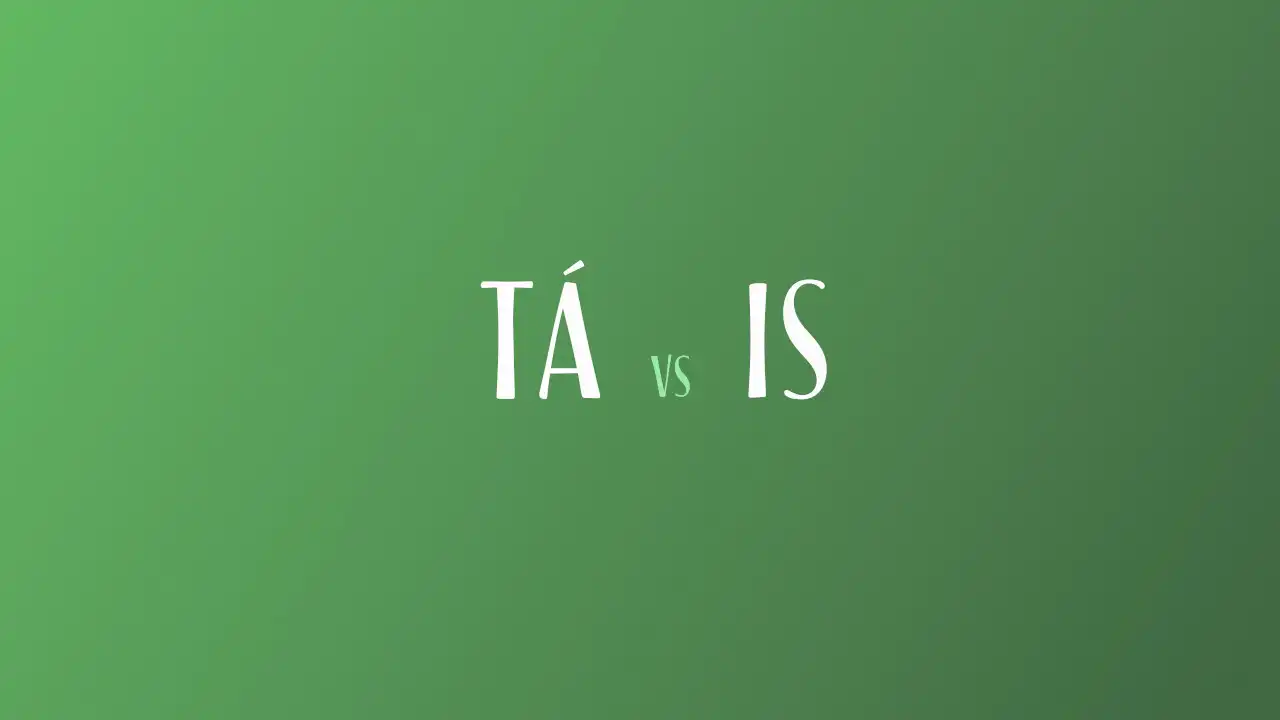Understanding 'Tá' vs. 'Is': The Two Verbs for 'To Be' in Irish
Author

One of the first big hurdles for learners of Irish is getting to grips with the verb ‘to be’. In English, we just have one verb: “I am happy”, “She is a doctor”, “It is on the table”. Simple enough!
But in Irish, we have two different verbs for ‘to be’: tá and is.
This might seem confusing at first, but don’t worry! The difference between them is quite logical. Think of them as having two different jobs. Once you understand their roles, you’ll know exactly which one to use.
Let’s break it down in a simple, straightforward way.
Table of Contents:
When to use tá (The ‘state’ verb)
Think of tá as the verb you use to describe a state, condition, or location. It tells you how something is, what it’s doing, or where it is right now. It often deals with things that can change.
You use tá in three main situations:
1. For locations
When you want to say where something or someone is located, you use tá.
Tá an cupán ar an mbord.
Tá Aoife sa bhaile.
2. For temporary states and conditions
Use tá to describe how something is feeling or its current condition. This includes emotions, physical feelings, and descriptions of things like the weather.
Tá mé tuirseach.
Tá an aimsir go hálainn inniu.
3. For descriptions with adjectives
When you’re describing a noun with a simple adjective (like its color, size, or shape), you use tá. The structure is: Tá + [thing] + [adjective].
Tá an carr gasta.
Tá an teach mór.
Quick Dialect Note: In Connacht (and Standard Irish), tá is pronounced like “taw”. In Ulster, it’s closer to “tah”.
When to use is (The ‘identity’ verb)
Think of is as the verb for identity, classification, or definition. It tells you what something or someone is in a more permanent or essential way. It’s used to link two nouns or a noun and a pronoun. Is is also known as “the copula”.
You use is for a few key jobs:
1. For identification (Who or What)
When you’re identifying a person or thing—saying who or what it is by name or category—you use is.
Is mise Aoife.
Is fear é.
This is a classic mistake for learners! You would never say Tá mé Aoife. Because “Aoife” is my name (my identity), I must use is.
2. For classification (Roles, Jobs, Nationalities)
When you are classifying someone by their job, role in society, or nationality, you use is.
Is dochtúir í.
Is múinteoirí iad.
Is Éireannach mé.
3. For ownership
When saying something belongs to someone, you often use is with the preposition le (with).
Is liomsa an leabhar.
The key takeaway is that is makes a statement about the fundamental identity of something, not just its temporary state.
Quick cheat sheet: tá vs. is
Here’s a simple table to help you remember the main differences.
| Use For… | Tá (The ‘State’ Verb) | Is (The ‘Identity’ Verb) |
|---|---|---|
| Location | ✔️ Tá sé sa chistin. (He is in the kitchen.) | ❌ |
| Temporary Condition | ✔️ Tá mé tinn. (I am sick.) | ❌ |
| Description (with an adjective) | ✔️ Tá an madra beag. (The dog is small.) | ❌ |
| Identification (Who/What is it?) | ❌ | ✔️ Is mise Pól. (I am Paul.) |
| Occupation/Role | ❌ | ✔️ Is feirmeoir í. (She is a farmer.) |
| Ownership | ❌ | ✔️ Is leatsa é. (It is yours.) |
What about questions and negatives?
Like most verbs, tá and is change their form when you ask a question or make a negative statement. Luckily, the rules are pretty simple.
For tá
- Question:
An bhfuil...?(Are/Is…?) - Negative:
Níl...(Am not / Is not / Are not…)
An bhfuil tú sona?
Níl mé sona.
For is
- Question:
An...?(Is…? / Are…?) - Negative:
Ní...(Is not… / Are not…)
An garda é?
Ní garda é.
Wrapping it up
So there you have it! The two verbs for ‘to be’ in Irish.
Just remember this simple rule of thumb:
Táis for how, where, or in what state something is.Isis for what something is.
It will feel strange at first, but with a little practice, choosing between tá and is will become second nature. The more you read and listen to Irish, the more you’ll get a feel for it.